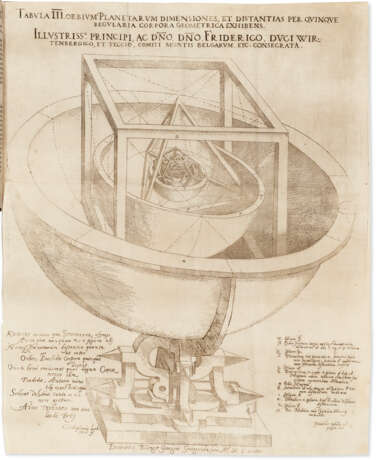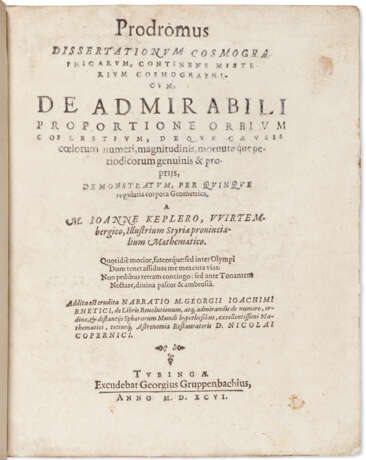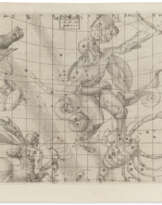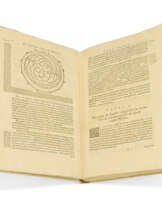ID 1360813
Лот 97 | Mysterium cosmographicum
Оценочная стоимость
$ 80 000 – 120 000
First edition of Kepler's first substantial work—the innovative Copernican treatise that launched his career and sowed the seeds of his revolutionary transformation of astronomy. Although Kepler had originally desired to become a pastor, the terms of his scholarship at Tübingen obligated him to take a post as a mathematics teacher in Graz in 1594. While teaching his students there, he had an epiphany which ultimately produced this remarkable Platonic-Pythagorean approach to the geometrical structure of the universe:
"Kepler demonstrated that by nesting the Platonic solids one inside the other and then circumscribing circles around each one to represent the planetary orbits, one could arrive at the distances between the planets, ordered according to Copernican theory. Because there were only five Platonic solids, it was clear that there would be precisely six planets. Kepler further argued that the structuring of the cosmos according to the Platonic solids made perfect sense, for geometry was the tool with which God had created the universe and all things in it. To be intelligible was to be geometrical, Kepler contended, because the human mind was imprinted with the very geometrical archetypes that also structured the cosmos and was therefore uniquely suited to understand God's creations" (Rothman).
Although Kepler's theory was incorrect (and he knew it—the math did not add up perfectly), the book's publication marked him as a creative and incisive thinker. And, more significantly, the unanswered questions posed in this work ultimately led Kepler to seek new and better sources of astronomical data—a journey which brought him to Tycho Brahe and the court of Rudolf II, and ultimately to the elliptical orbit of Mars and the laws of planetary motion. This drive to understand the mathematical structure of the solar system underlies all his major work, and he would revisit the idea of the Platonic solids in his 1619 work, Harmonices mundi. "The vision of a cosmos organized by ideal Platonic geometry may seem quaint in retrospect, but Kepler's transformational insight was that a truly successful model of the cosmos must account for the entire three-dimensional space of the heavens rather than just a linear sequence of celestial spheres ... in the Mysterium cosmographicum, his empirically inaccurate but aesthetically beautiful example of geometric thinking pointed the way from an astronomy of spheres towards a physics of cosmic space" (Galle).
One of the first substantial defenses of Copernican theory, the Mysterium cosmographicum provides the first demonstration of the special insight Kepler would use to transform early modern astronomy: this conviction that the abstract world of pure mathematics could and should also represent physical truths. In it, he writes that "these hypotheses of Copernicus not only do not sin against the nature of things, but very much delight in it" and insists that his proof could even convince Aristotle himself. This book is very rarely complete at auction; the last copy with all the folding plates to sell was in the Honeyman sale in 1980. Caspar 6; not in Norman. See Aviva Rothman, The Pursuit of Harmony: Kepler on Cosmos, Confession, and Community (2017) and Karl Galle, "A geometrical system of the heavens," in Thinking 3-D, edited by Daryl Green and Laura Moretti (2019).
Quarto (188 x 151mm). With five folding plates, one of which is engraved, woodcut diagrams in text (title and following page with paper strengthened, mostly marginal pale dampstain but affecting text in gatherings K-Q, first two folding woodcut plates with some cleaned mold-spots still visible, T gathering browned). 17th-or 18th-century calf, spine gilt in compartments, paste-paper endpapers (wear to spine ends). Provenance: Owen Gingerich (bookplate).
| Автор: | Иоганн Кеплер (1571 - 1630) |
|---|---|
| Место происхождения: | Германия |
| Автор: | Иоганн Кеплер (1571 - 1630) |
|---|---|
| Место происхождения: | Германия |
| Адрес торгов |
CHRISTIE'S 20 Rockefeller Plaza 10020 New York США | ||||||||||||||
|---|---|---|---|---|---|---|---|---|---|---|---|---|---|---|---|
| Предосмотр |
| ||||||||||||||
| Телефон | +1 212 636 2000 | ||||||||||||||
| Факс | +1 212 636 4930 | ||||||||||||||
| Условия использования | Условия использования | ||||||||||||||
| Транспортировка |
Почтовая служба Курьерская служба Самовывоз | ||||||||||||||
| Способы оплаты |
Банковский перевод | ||||||||||||||
| Часы работы | Часы работы
|












